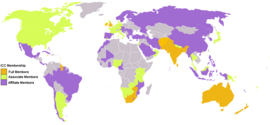Twenty20 Cricket was first played in English domestic cricket in 2003 to popularise first-class cricket and attract more spectators. It has since spread to many other countries. A "Twenty20 Game" consists 20 overs for each side, a free-hit after a no-ball is bowled, short boundaries, batting-friendly pitches, and other rules designed to attract crowds that would not be willing to sit through the slower-paced one-day games or test matches. The first men's Twenty20 international was between Australia and New Zealand in 2005, the first women's Twenty20 international having been between England and New Zealand in 2004. The ICC announced after its Executive Board meeting in March 2006 that beginning from 2007 to 2015, the Twenty20 World Championship would be held every two years, the first ever Twenty20 World Championship to be held in South Africa in 2007.[6]
First-class matches
A first-class match is generally defined as a high-level international or domestic match that takes place over at least three days on natural (as opposed to artificial) turf. First-class games are two innings per side. Like Test matches, if the game is not completed over the allotted time then it is drawn. Games where the teams have only one innings each are not first-class (including one-day internationals).
A two-innings match of at least three days duration is granted first-class status only if both teams have first-class status. For example, Test matches, other games between two Test nations, games between two domestic teams deemed first-class in countries holding full membership of the ICC, and games between a Test nation's national side (or a team drawn from a national touring squad) and a first-class domestic team from a Test nation, are usually deemed to be first class. Matches between Kenya, one of the leading associate members of the ICC, and another team adjudged first-class are usually granted first-class status, but domestic matches in Kenya are not.
Among cricket statisticians, first class cricket is variously deemed to have started in 1660, 1772, 1801, 1815 or 1864. This ongoing controversy is described in the main article. The limited overs equivalent of first-class status is list A status.
Other forms of cricket
At all levels, the rules of cricket are often modified. At international or first-class levels this is usually in order to make the game more commercially attractive. More or less formal domestic club cricket matches are usually played over one to two days, either two innings per side or one innings per side with limited overs. At lower levels the rules are often changed simply to make the game playable with limited resources, or to render it more convenient and enjoyable for the participants. Variants of the sport are played in areas as diverse as sandy beaches and ice floes. Families and teenagers play backyard cricket in suburban yards or driveways, and the teeming cities of India and Pakistan play host to countless games of 'Gully Cricket' or 'Tapeball' on their streets. Tennis balls and homemade bats are often used, and a variety of objects may serve as wickets such as the batters legs, as in "French Cricket", which did not in fact originate in France, and is usually played by small children. Sometimes the rules are also improvised: for instance it is sometimes agreed that fielders can catch the ball with one hand after one bounce and claim a wicket, or if only a few people are available then everyone may field while the players take it in turns to bat and bowl.
In Kwik cricket, the bowler does not have to wait for the batsman to be ready before a delivery, leading to a faster, more exhausting game designed to appeal to children, which is often used in English schools' PE lessons. Another modification to increase the pace of the game is the "Tip and Run", "Tipsy Run" or "Tippy-Go" rule, in which the batter must run when the ball touches the bat, even if it the contact is unintentional or minor. This rule, seen only in impromptu games, speeds the match up by disabling the batsman's ability to block the ball. Indoor cricket is played in a netted, indoor arena.
In Samoa a form of cricket called Kilikiti is played in which hockey stick-shaped bats are used.
In Estonia, teams gather over the Winter for the annual Ice Cricket tournament. The game juxtaposes the normal summer pirsuit with harsh, wintry conditions. Rules are otherwise similar to those for the six-a-side game.
International structure
Cricket is the second most popular sport in the world.[7][1][2][8][9][10][11][12][3] More than 120 cricket-playing nations are recognised by the International Cricket Council.[13] In the countries of South Asia, including India, Pakistan, Bangladesh, Afghanistan, Nepal and Sri Lanka, cricket is the most popular sport.[14][15][16] Similarly, it is the most popular sport in Australia,[17] United Arab Emirates,[18] Bermuda,[19] Cayman Islands[20] and the English-speaking countries of the Caribbean, which are collectively known in cricketing parlance as the West Indies.[21] Cricket is also the national sport of England[22] and The Bahamas,[23] and a major sport in the countries of Europe (including Wales,[24] Scotland,[25] Ireland[26] and Italy[27]), Africa (containing South Africa,[28] Zimbabwe,[29] Kenya,[30] Namibia,[31] Uganda[32] and Zambia[33]), Asia (including Hong Kong,[34] Fiji[35] and Papua New Guinea[36]), and in New Zealand,[37] etc.
Cricket is internationally governed by International Cricket Council (ICC), which is headquartered in Dubai and includes representatives from the ten Test-playing nations and an elected panel representing non-Test-playing nations.
Each nation has a national cricket board which regulates cricket matches played in its country. The cricket board also selects the national squad and organises home and away tours for the national team.
Nations playing cricket are separated into three tiers depending on the level of cricket infrastructure in that country. At the highest level are the Test-playing nations; they qualify automatically for the quadrennial World Cup matches. Below these are the Associate Member nations. The lowest level consists of the Affiliate Member nations.
See also: Non-Test teams to have played ODI matches.


No comments:
Post a Comment